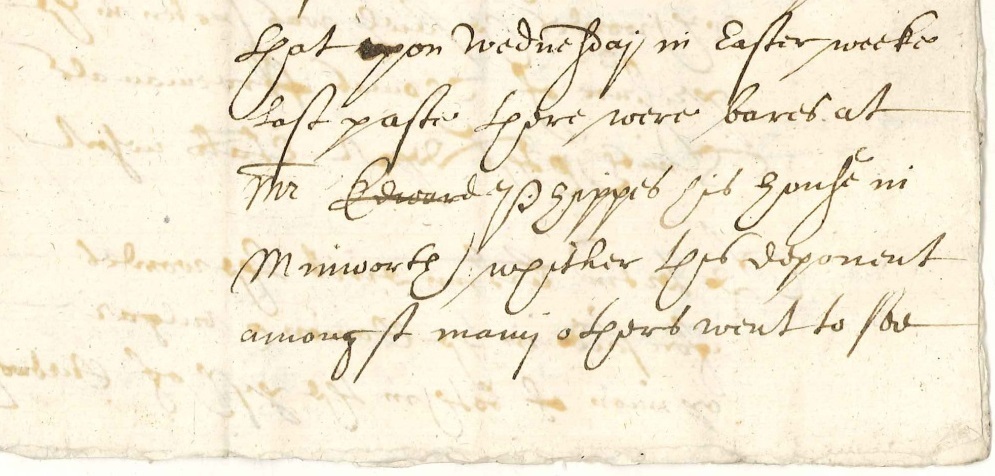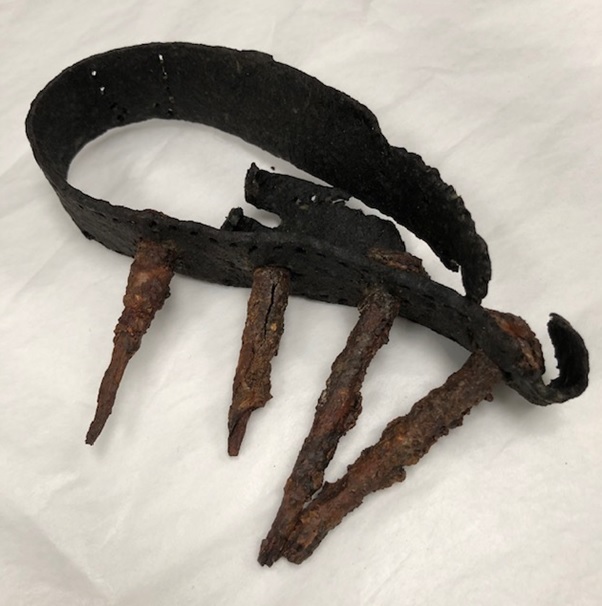 D4080-17-389 Detail
This may be the only image in the archive collection that purports to show paranormal activity!
The background of the image is that it was taken in the earlier part of the 20th century, looking towards the altar of Checkley Church. The description written on the image simply says ‘Checkley Church – ghosts?’ and the image might appear to show a group of figures, possibly wearing long white ecclesiastical robes, gathered around the altar. Those of a paranormal persuasion might suggest these are indeed ghosts of clergymen or (the ghosthunter’s favourite) white-robed monks.
For those seeking a more rational explanation, the period the photograph was taken might be a clue. As it’s early 20th century, the camera of the time would need a long exposure to adequately capture an interior scene, especially in a dark church. It is possible that the photographer left the camera on long exposure, during which time the vicar (or other church official) approached the altar from one side, performed religious observance in front of it and then moved off towards the opposite side of the church. As they passed in front of the altar, paused and then moved on, the camera exposure picked up multiple images of the same person, creating the ghostly gathering that appears in the photograph.
Or perhaps it really is a group of long-dead clergymen returned to celebrate a ghostly mass…
 Bears in the Barn
“Upon Wednesday in Easter weeke last paste there were bares at Mr Edward Phippes his house in Minworth whither this deponent amongst many others went to see.”
 BC5-1628-12
Although these cases give us insights into day to day life, they also throw up some unusual occurrences. Here, it is a rather small detail, a comment that the witness shares.
In a defamation case in 1628; Edward Freeman of Curdworth is accused of saying ‘thou art a cuckoldie fool’
The plaintiff, Richard Wright of Curdworth was a ‘barewarden’. Witnesses Edward Jackson, aged 26, who was a tailor from Handsworth and Thomas Freeman, aged 30, of Curdworth (perhaps related to the defendant) who worked as a nailer stated that this slander occurred whilst a crowd had gathered to see the bears in the barn of Mr Phippes at Minworth.
But why and how would Mr Phippes be keeping bears in his barn? And what is a ‘barewarden’?
In the UK brown bears in the wild went extinct in the early medieval period, it was thought they had been brought to Britain by the Romans. However from the 15th century many towns had bears which were used for entertainment.
Bear baiting was popular. They were made to fight smaller animals to the death, it was an ugly and brutal sport. There were those who opposed it, but they were generally more concerned with the gambling, drinking and prostitution that the sport was supposed to encourage rather than the welfare of the poor animals involved. However, bears were expensive to import and therefore the organisers wanted to keep them alive as long as possible, so they were often pitted to win and looked after when they weren’t fighting. A bear warden would take care of bears and other animals. They would train and care for them. Some bears were much loved in their towns.
In Congleton, Cheshire the town bear brought tourists and income to the area through bear baiting and dancing and was much loved. So when it died, sometime in the 17th century, they bought a new one, having borrowed money from a fund set aside for a new town bible. Over the years the story has translated into ‘the town sold its bible for a bear’ and it became known as Beartown.
This collar in the Staffordshire County Museum collection was found in Winsford in Cheshire on a derelict site in a layer of ash two feet down from the surface. The site formerly held lots of fairs, so it is assumed that this could be a collar for dancing bears.
 Bear Collar (71.050.0001)
But Curdworth where our defamation case takes place sits in Warwickshire, and Minworth was a small hamlet nearby. Warwickshire has a long standing relationship with the bear as it is part of the county’s heraldry. The bear and staff symbol’s origins have been lost over time but in the 17th century William Dugdale believed that it was connected to legend; a knight at King Arthur’s round table. Arthgallus, was an earl of Warwick and his name came from the Welsh for bear; ‘arth’
Unfortunately it is doubtful that Mr Phippes had any noble notions for the bears in his barn. It is likely that the bears may have been preparing to fight and that why crowds had gathered.
In the 18th century bear baiting, bull baiting, dog and cockfighting were becoming less and less acceptable in society due to the rowdiness of crowds and the cruelty to animals. They were finally banned in 1834.
 Julie working at the Staffordshire Record Office
This week we meet Julie O'Neill, Records Office Manager, a keen dogwalker and fan of the festive season.
What does your role involve?
My job is the premise management of the Records Office and William Salt Library, this involves dealing with contractors, arranging service visits, regular monitoring and building checks and dealing with any emergencies that come up within the buildings. I am also responsible for Health & Safety, creating and updating risk assessments for the buildings and staff and dealing with any issues that arise. Other duties include ordering goods and services, budget monitoring and creating rota’s.
When did you start working with the Archives and Heritage Service?
I have been working in the Archives and Heritage Service since October 2007.
What made you choose this career?
I have worked within Staffordshire County Council since November 1999, I saw the Records Office Manager position advertised and thought that sounds really interesting!! Luckily I was successful in my application and have not looked back!!
What is your favourite object or document or photograph from the collection?
As I mainly deal with the buildings I do not have a great knowledge of the collections so could not really answer that question, however I do enjoy seeming them in all their glory when we have an exhibition – and if it happens to be a Christmas related exhibition all the better!!!
What is your most memorable moment about working for the Service?
Gosh that is a hard question!! I think the people I work with make it memorable, also the events that we put on – all of the hard work and effort that goes into them by staff, being enjoyed by members of the public either through Roadshows, History Days, exhibitions, talks, etc.
Away from work, do you have a hidden talent or special skill?
I have worked for a number of years in entertainment which included croupier work on fun casinos – which means a lot of smiling, and patience!!! More recently before lockdown we acquired a four legged lodger who is still with us, and I have also been walking a neighbour’s dog since lockdown – so dog walking has become a new skill!!!

Join us in The Learning Room to discover a range of articles based on research and collections across the Archives and Heritage Service. You can sign up here
Our aim is to keep you updated with the latest developments and events. If you do not wish to receive this newsletter please use the 'unsubscribe' button at the bottom of this page.
|